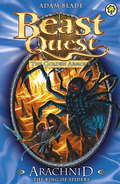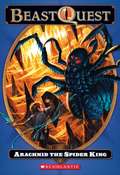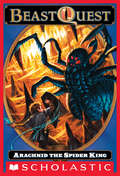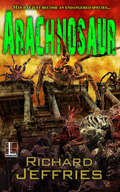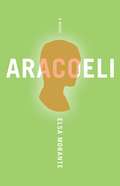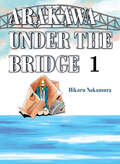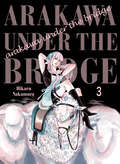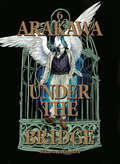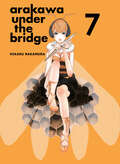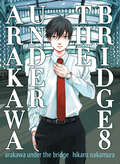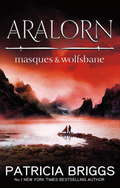- Table View
- List View
Arachne the Weaver
by Rebecca Grudzina Lori O'Dea Niki LeonidouThe goddess Athena challenges Arachne to a weaving contest and ends up a sore loser.
Arachne the Weaver
by Rebecca Grudzina Lori O'Dea Niki LeonidouThe goddess Athena challenges Arachne to a weaving contest and ends up a sore loser.
Arachnid the King of Spiders: Series 2 Book 5 (Beast Quest #11)
by Adam BladeBattle fearsome beasts and fight evil with Tom and Elenna in the bestselling adventure series for boys and girls aged 7 and up. The Evil Wizard Malvel has stolen the magical suit of golden armour and scattered it throughout Avantia. Tom vows to find the pieces - but they are guarded by six terrifying new Beasts! In the caves of Avantia lurks Arachnid the King of Spiders. Massive and terrifying, Arachnid preys on the local townspeople and guards a piece of the magical golden armour. Can Tom defeat the Beast and save the kingdom from destruction?There are SIX thrilling adventures to collect in the Beast Quest: The Golden Armour series: Zepha the Monster Squid; Claw the Giant Monkey; Soltra the Stone Charmer; Vipero the Snake Man; Arachnid the King of Spiders; Trillion the Three-Headed Lion.If you like Beast Quest, check out Adam Blade's other series: Team Hero, Sea Quest and Beast Quest: New Blood!
Arachnid the Spider King (Beast Quest, Book #11)
by Adam BladeIn the caves of Avantia lurks Arachnid, the King of Spiders. Massive and terrifying, Arachnid preys on the local townspeople and guards a piece of the magical golden armor. Can Tom defeat the Beast and save the kingdom from destruction?
Arachnid the Spider King: Arachnid the Spider King (Beast Quest #11)
by Adam BladeOne boy's journey to save his village becomes a quest to save the Kingdom.In the caves of Avantia lurks Arachnid the Spider King. Massive and terrifying, Arachnid preys on the local townspeople and guards a piece of the magical golden armor. Can Tom defeat the Beast and save the kingdom from destruction?
Arachnoid Cysts: State-of-the-Art
by Walter A. Hall Mehmet Turgut Ali Akhaddar Ahmet T. TurgutThis book provides an in-depth review of the knowledge of craniospinal arachnoid cysts, with emphasis on epidemiology, genetics, neuroimaging, clinical presentations, and operative management. Sections on postoperative complications, outcome, and medicolegal aspects of this entity are also included. This richly illustrated book will help the reader in choosing the most appropriate way to manage this challenging neurosurgical disease process. This work also considers future areas of investigation and innovative therapeutic philosophies. This comprehensive reference book will be an ideal source for neuroscientists at all levels of their training in multiple different disciplines, from graduate students to specific research scientists studying this topic, including neurosurgeons, neurologists, neuroradiologists, pediatricians, and those seeking both basic and more sophisticated information regarding craniospinal arachnoid cysts.
Arachnophobia
by Nicholas EdwardsBased on the Motion Picture, Arachnophobia, from Hollywood Pictures and Amblin Entertainment, Inc.
Arachnosaur
by Richard JeffriesDESERT SWARM After his superior officers are killed in action, Corporal Josiah Key assumes command of the 3rd Battalion, Marine Raiders. In the tiny village of Shabhut, Yemen, while trying to put the blast on ISIS forces, an even deadlier enemy emerges: ancient, unreasoning creatures who tear into both U.S. troops and terrorists without mercy, leaving brutally dismembered corpses in their wake. They are known as the Idmonarchne Brasieri, giant prehistoric spiders roused from millennia-long slumber by power-mad terrorists. These aptly-named ‘Arachnosaurs’ are hungry. They’re angry. And they have declared war against all of humanity . . . whose days might just be numbered unless Key and his unit can stop them. ARACHNOSAUR
Aracoeli
by William Weaver Elsa Morante<P>Aracoeli―Elsa Morante's final novel―is the story of an aging man's attempt to recover the past and get his life on track in the process. The Aracoeli of the title is the narrator's deceased mother, who grew up in a small Spanish town before marrying an upper-class Italian navy ensign. The idyllic years she spends with her only son―Manuel, the narrator of the novel―are shattered when she contracts an incurable disease (probably syphilis) and becomes a nymphomaniac. <P>Now, at the age of 43, Manuel, an unattractive, self-loathing, recovering drug addict who works a dead-end job at a small publishing house, decides to travel to her hometown in Spain in order to look for her. Filled with dreams and remembrances the novel creates a Sebaldian landscape of memory out of this painful journey, painting a portrait that is both touching and bleak. <P>Appearing here for the first time in paperback―the hardcover was published in 1984―Aracoeli is an important, and long-neglected, work in Morante's oeuvre.
Aracruz Celulose S.A.: Managing a Renewable Resource
by Ray A. Goldberg1994 was a turnaround year for pulp prices and the Aracruz company. How does the company respond to environmental pressures and to new types of competition in the industry? Teaching Purpose: Indicates how to position oneself in the value-added timber/pulp industry in an environment-friendly manner.
Aracy de Carvalho and Jewish Rescue from 1930s Germany: A Righteous Brazilian
by Mônica Raisa SchpunAracy de Carvalho (1908-2011), 'Righteous Among the Nations', saved German Jews by facilitating their emigration to Brazil in the late 1930s, while working at the Brazilian consulate in Hamburg. Margarethe Levy (1908-2011), who left for Brazil shortly after Kristallnacht with her husband, was one such case. In the late 1970s, she claimed the title of Righteous from Yad Vashem for Carvalho, who had become her lifelong friend. The main thread of this book follows the crossed migrations of these two women between Brazil and Germany, and the long friendship that brought them together. Through this axis it traces the migratory paths of a group of German Jews who, like Levy, left Hamburg to settle in São Paulo.
Aradia or the Gospel of the Witches
by Charles G. LelandThe text is a composite. Some of it is Leland's translation into English of an original Italian manuscript, the Vangelo (gospel). Leland reported receiving the manuscript from his primary informant on Italian witchcraft beliefs, a woman Leland referred to as "Maddalena" and whom he called his "witch informant" in Italy. The rest of the material comes from Leland's research on Italian folklore and traditions, including other related material from Maddalena. Leland had been informed of the Vangelo's existence in 1886, but it took Maddalena eleven years to provide him with a copy. After translating and editing the material, it took another two years for the book to be published. Its fifteen chapters portray the origins, beliefs, rituals and spells of an Italian pagan witchcraft tradition. The central figure of that religion is the goddess Aradia, who came to Earth to teach the practice of witchcraft to peasants in order for them to oppose their feudal oppressors and the Catholic Church.
Aradia: A Modern Guide to Charles Godfrey Leland's Gospel of the Witches
by Craig SpencerA Revelatory New Approach to the Influential Witchcraft ClassicFirst published in 1899, Aradia, or the Gospel of the Witches is Charles Godfrey Leland's fascinating record of folk magic, said to have been revealed to him by hereditary witches of Italy's Romagna and Tuscany regions. Celebrating the goddess Diana and her daughter Aradia, this seminal work presents a rich and complete methodology of practice for those who are willing to engage its unique wisdom.Aradia presents Leland's original English manuscript with new interpretations and translations, including forty lines never before rendered in English. Craig Spencer provides in-depth commentary that reveals the rich historical context of this profound work and provides revelatory analysis that makes the true heart of the original come alive. You will also discover hands-on instructions for a unique magical practice based on Leland's remarkable glimpse into nineteenth-century craft lore. This magical guide is designed to help you expand and enhance your own modern-day journey through the enchanted realms of witchcraft.
Arafat's War: The Man and His Battle for Israeli Conquest
by Efraim KarshOffering the first comprehensive account of the collapse of the most promising peace process between Israel and the Palestinians, historian Efraim Karsh details Arafat's efforts since the historic Oslo Peace Accords in building an extensive terrorist infrastructure, his failure to disarm the extremist groups Hamas and Islamic Jihad, and the Palestinian Authority's systematic efforts to indoctrinate hate and contempt for the Israeli people through rumor and religious zealotry.Arafat has irrevocably altered the Middle East's political landscape, and while his place in history has yet to be written, the ongoing Israeli-Palestinian conflict will always be Arafat's war.
Arakawa Under the Bridge 1 (Arakawa Under the Bridge #1)
by Hikaru Nakamura&“Could you help me fall in love?&” Kou Ichinomiya, a young man born with a silver spoon in his mouth and raised with the mantra &“never owe anyone&” suddenly finds himself deeply indebted to a young homeless woman, Nino, who lives on the Arakawa river bank and claims to originally be from the planet Venus. When Nino rejects all of Kou&’s mundane offers of money or housing, Kou is at a loss for how to repay his debt, until Nino suddenly asks him to teach her about love. A daunting task, but the over-achieving Kou is determined to return Nino&’s favor. And so begins Kou&’s life under the bridge, along with a band of eccentric characters who have formed their own little community outside the boundaries of typical Tokyoite life…
Arakawa Under the Bridge 2 (Arakawa Under the Bridge #2)
by Hikaru NakamuraBest-selling mangaka Hikaru Nakamura (Saint Young Men) makes her English language debut with this surreal comedy starring a 620-year-old water sprite, a man with a star for a head, a nun, and a samurai who runs a barber shop under Tokyo's Arakawa Bridge. Part 2 contains volumes 3 and 4 of the Japanese edition.Rec, insulted by the insinuation that he has nothing to contribute to the community under the bridge, decides to start a school. Rec&’s secretaries from his company in the outside world investigate his current situation, reports of which are sent back to his father, who then targets the river bank for redevelopment, threatening the idyllic lifestyle of the river bank denizens...
Arakawa Under the Bridge 3 (Arakawa Under the Bridge #3)
by Hikaru NakamuraBest-selling mangaka Hikaru Nakamura (Saint Young Men) makes her English language debut with this surreal comedy starring a 620-year-old water sprite, a man with a star for a head, a nun, and a samurai who runs a barber shop under Tokyo's Arakawa Bridge. Part 3 contains volumes 5 and 6 of the Japanese edition.&“Nino, I promise that I can accept everything about you!&” Rec calls out when he discovers Nino&’s secret trove of cassette tapes. Rec and Nino are both clumsy when it comes to communication, which leads to situations both humorous and heartbreaking. Once in a while a sombre mood falls upon the river bank under the bridge... until the next absurd turn of events comes around.
Arakawa Under the Bridge 4 (Arakawa Under the Bridge #4)
by Hikaru NakamuraBest-selling mangaka Hikaru Nakamura (Saint Young Men) makes her English language debut with this surreal comedy starring a 620-year-old water sprite, a man with a star for a head, a nun, and a samurai who runs a barber shop under Tokyo's Arakawa Bridge. &“Let&’s go to Venus!&”And so the river bank denizens begin training that will let them go to Nino&’s extraterrestrial hometown. But do any of them have what it takes to make it in space? A trip upstream brings Rec into contact with a tribe ruled by an Amazoness, who soon sees Nino as her rival. Everyone helps build a house for the Mayor and a park for the Metal Brothers. As the cast of characters expands daily life on the river bank becomes ever more eventful…
Arakawa Under the Bridge 5 (Arakawa Under the Bridge #5)
by Hikaru NakamuraBest-selling mangaka Hikaru Nakamura (Saint Young Men) makes her English language debut with this surreal comedy starring a 620-year-old water sprite, a man with a star for a head, a nun, and a samurai who runs a barber shop under Tokyo's Arakawa Bridge. Part 5 contains volumes 9 and 10 of the Japanese edition. The aura of craziness emanating from the Arakawa river bank keeps luring in those who want to fly their own freak flag, including, of all people, Rec&’s secretary Shimazaki. As the day of the launch to Venus, Nino&’s home planet, draws ever closer, everyone must make their preparations and say farewell to those who are earth-bound. Will the rocket, filled with the hopes of its crew, be able to make the interplanetary journey…?
Arakawa Under the Bridge 6 (Arakawa Under the Bridge #6)
by Hikaru NakamuraBest-selling mangaka Hikaru Nakamura (Saint Young Men) makes her English language debut with this surreal comedy starring a 620-year-old water sprite, a man with a star for a head, a nun, and a samurai who runs a barber shop under Tokyo's Arakawa Bridge. Part 6 contains volumes 11 and 12 of the Japanese edition. The Venus-bound rocket successfully launched against all odds… and now Rec is back after an out-of-this-world encounter with Nino&’s folks, and even Takai had his own alien encounter that leaves him transformed. As the seasons turn, everyone&’s eccentricities spiral out and twine together, and the Mayor finds himself expecting…!
Arakawa Under the Bridge 7 (Arakawa Under the Bridge #7)
by Hikaru NakamuraBest-selling mangaka Hikaru Nakamura (Saint Young Men) makes her English language debut with this surreal comedy starring a 620-year-old water sprite, a man with a star for a head, a nun, and a samurai who runs a barber shop under Tokyo's Arakawa Bridge. Part 7 contains volumes 13 and 14 of the Japanese edition. Under the waters of the Arakawa lies the Kapa House. Under the Kapa House is a secret room only those dubbed &“mayor&” are allowed to enter. Inside the room someone casts charms to protect the Arakawa river bank from unwanted intruders...
Arakawa Under the Bridge 8 (Arakawa Under the Bridge #8)
by Hikaru NakamuraBest-selling mangaka Hikaru Nakamura (Saint Young Men) makes her English language debut with this surreal comedy starring a 620-year-old water sprite, a man with a star for a head, a nun, and a samurai who runs a barber shop under Tokyo's Arakawa Bridge. The heartwarming romantic antics of the river bank denizens–both human and alien–draw to a close in this final volume. Shadowy incidents in the past are brought to light, and each character takes a fateful step towards the future. Nino finally ventures outside, yet is foiled by fowl... Rec goes after her, even though the risk of literal heartbreak is real. Join the gang under the bridge for one last hurrah!
Aralkum - a Man-Made Desert: The Desiccated Floor of the Aral Sea (Central Asia) (Ecological Studies #218)
by Siegmar-W. Breckle Liliya A. Dimeyeva Nathalia P. Ogar Walter WuchererHaving been the fourth largest lake on the globe roughly 50 years ago, today the Aral Sea no longer exists. Human activities caused its desiccation and the formation of a huge new desert, the Aralkum, which can be regarded as one of the greatest ecological catastrophes and - at the same time - the largest primary succession experiment of mankind. This volume brings together the results of international and interdisciplinary long-term studies on the new desert ecosystem and is divided into four main sections. The first section provides an overview of the physical characteristics of the area and covers geological, pedological, geomorphological and climatological aspects and their dynamics, especially dust-storm dynamics. The second focuses on the biotic aspects and highlights the spatial and temporal patterns of the flora and fauna. In the third section studies and projects aiming to combat desertification by phytomelioration and to develop strategies for the conservation of biodiversity are presented. The book is rounded off with a section providing a synthesis and conclusions.
Aralorn: Masques and Wolfsbane
by Patricia BriggsA breathtaking epic fantasy adventure from the bestselling Patricia Briggs, author of the Mercy Thompson novels.After an upbringing of proper behaviour and oppressive expectations, Aralorn fled her noble birthright for a life of adventure as a mercenary spy. But her latest mission involves more peril than she ever imagined.Agents of Sianim have asked her to gather intelligence on the increasingly popular and powerful sorcerer Geoffrey ae'Magi. Soon Aralorn comes to see past the man's striking charisma - and into a soul as corrupt and black as endless night. And few have the will to resist the sinister might of the ae'Magi and his minions.So Aralorn, aided by her enigmatic companion, Wolf, joins the rebellion against the ae'Magi. But in a war against a foe armed with the power of illusion, how do you know who the true enemy is - or where he will strike next?This omnibus edition contains the two titles MASQUES and WOLFSBANE.Books by Patricia Briggs:Books three and four in the Sianim seriesSteal the DragonWhen Demons WalkHurogDragon BonesDragon BloodRaven duologyRaven's ShadowRaven's StrikeMercy ThompsonMoon CalledBlood Bound Iron KissedBone CrossedSilver MarkedFrost BurnedNight BrokenFire TouchedSilence FallenStorm CursedSmoke BittenAlpha and OmegaAlpha & OmegaCry WolfHunting GroundFair GameDead HeatBurn Bright
Aramaic: A History of the First World Language (Handbook Of Oriental Studies. Section 1 The Near And Middle East Ser. #111)
by Holger GzellaIn this volume—the first complete history of Aramaic from its origins to the present day—Holger Gzella provides an accessible overview of the language perhaps most well known for being spoken by Jesus of Nazareth. Gzella, one of the world&’s foremost Aramaicists, begins with the earliest evidence of Aramaic in inscriptions from the beginning of the first millennium BCE, then traces its emergence as the first world language when it became the administrative tongue of the great ancient Near Eastern empires. He also pays due diligence to the sacred role of Aramaic within Judaism, its place in the Islamic world, and its contact with other regional languages, before concluding with a glimpse into modern uses of Aramaic. Although Aramaic never had a unified political or cultural context in which to gain traction, it nevertheless flourished in the Middle East for an extensive period, allowing for widespread cultural exchange between diverse groups of people. In tracing the historical thread of the Aramaic language, readers can also gain a stronger understanding of the rise and fall of civilizations, religions, and cultures in that region over the course of three millennia. Aramaic: A History of the First World Language is visually supplemented by maps, charts, and other images for an immersive reading experience, providing scholars and casual readers alike with an engaging overview of one of the most consequential world languages in history.

